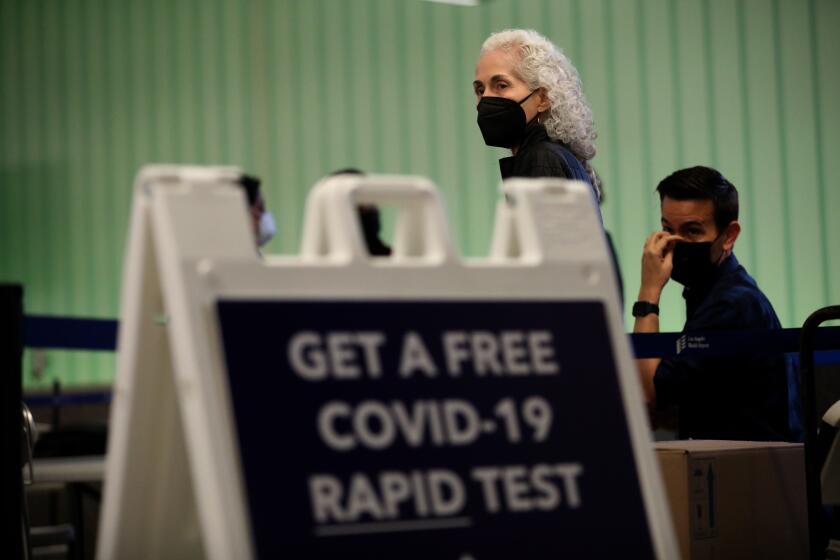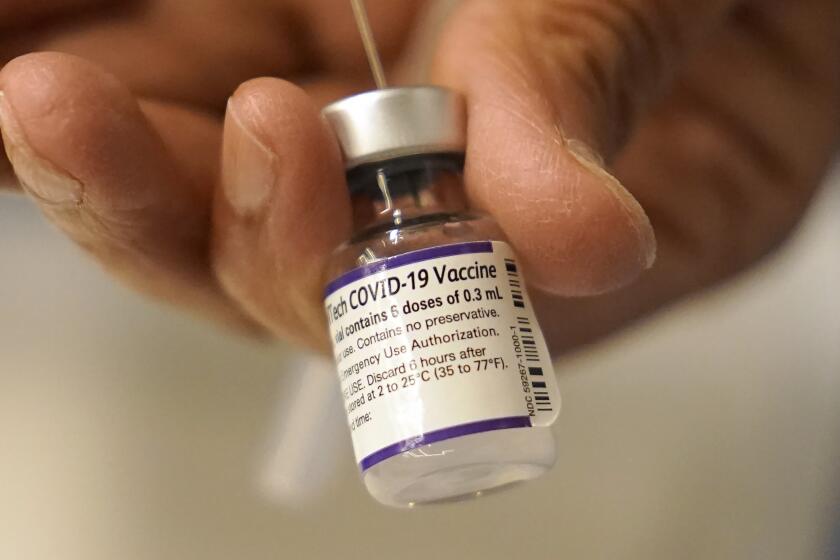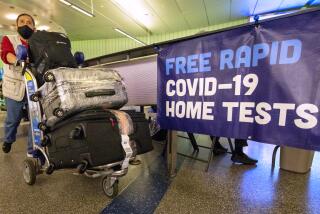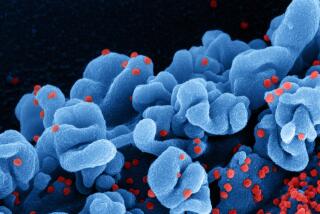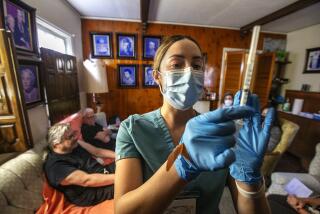Signs of Omicron found in California wastewater, suggesting variant is widespread

Signs of the Omicron variant of the coronavirus have been found in California’s wastewater, officials said, as the number of cases associated with the new variant rose to double digits, including two new infections in Los Angeles County confirmed since Tuesday.
Clues suggestive of Omicron’s presence in the Central Valley were picked up in wastewater samples collected in Sacramento and Merced counties, state epidemiologist Dr. Erica Pan said this week in a discussion hosted by the California Medical Assn.
“We definitely are seeing Omicron across the state, for sure,” Pan said.
It’s still far from clear what kind of COVID-19 increase California will see, and the state so far has been doing better than other parts of the country. But officials say they want to be ready.
In Sacramento County, Stanford University researchers detected a distinctive mutation that is found in Omicron from wastewater collected Nov. 30, according to a statement provided by county spokesperson Janna Haynes. Results were confirmed Monday, the county said.
“These findings indicate that the Omicron variant is most likely present in Sacramento County,” the statement said.
Pan said the mutation was also found in a wastewater sample collected in Merced County.
By Wednesday night, California’s tally of confirmed Omicron cases reached 12, with six cases in Alameda County, five in Los Angeles County and one in San Francisco.
L.A. County reported a new Omicron case Wednesday night, possibly a result of local transmission, in a fully vaccinated person who had received a booster and suffered only mild symptoms. Several close contacts of that person have also tested positive for the coronavirus, and work is underway to determine whether those cases involve the Omicron variant. Some of the close contacts are fully vaccinated; the vaccination status of others is under investigation.
A day earlier, Long Beach, which has its own health department, reported an Omicron case in a fully vaccinated resident who was experiencing no symptoms and who had traveled abroad, although not to southern Africa. The largest proportion of confirmed Omicron cases has been among people in southern Africa.
L.A. County reported its second and third Omicron cases on Monday: a USC student who had recently returned from the East Coast and someone who traveled from western Africa.
Gov. Gavin Newsom, in an interview with ABC’s “GMA3” morning program, said he expects more Omicron cases to emerge.
Still, scientists say it’s unclear whether Omicron will become the nation’s dominant strain, displacing Delta, which now accounts for more than 99% of analyzed coronavirus cases nationwide — a point Newsom underscored.
“Here’s the deeper point: The Delta variant is the issue. And it’s the issue driving increases in 30 states over the last few weeks, driving hospitalizations and ICUs,” Newsom said. “And it’s why we’re still very cautious and promoting and very aggressive on boosters and vaccinations.”
The six Omicron cases in Alameda County were among 12 coronavirus cases in people who were guests at a wedding in Wisconsin on Nov. 27. All were younger than 50 and had mild symptoms. They were all vaccinated, and most had received their booster shots, Pan said.
Eleven of the 12 people are staff members at Kaiser Oakland Medical Center, Kaiser Permanente said in a statement. Kaiser identified eight patients and eight staff members who were potentially exposed to those involved in the outbreak; 13 have tested negative, and the test results from three more close contacts are still being processed.
The index case, or the first infected person in the outbreak, is believed to be an Alameda County resident who attended the wedding after returning from Nigeria on Nov. 24 — the same day that scientists in South Africa disclosed their discovery of the new variant and two days before the World Health Organization declared Omicron a variant of concern. The wedding in Wisconsin had more than 100 people, and there were events at which people were masked and unmasked.
The California Department of Public Health said Wednesday night that a sixth Omicron case had been confirmed in Alameda County. An Alameda County spokesperson confirmed the sixth case was among the residents who attended the wedding in Wisconsin.
Pfizer says a booster dose of its COVID-19 vaccine may protect against the new Omicron variant, which early indications show might be more contagious.
There are reasons to be concerned about how transmissible the Omicron variant is. Pan referred to a report published by the U.S. Centers for Disease Control and Prevention that detailed a case of probable airborne transmission in a Hong Kong quarantine hotel between airline passengers staying across the hallway from each other.
“Retrospective investigation, including closed-circuit television camera footage, confirmed that neither case-patient left their room during the quarantine period. No items were shared between rooms, and other persons did not enter either room,” the report said.
“The only time the two quarantined persons opened their respective doors was to collect of food that was placed immediately outside each room door. The only other time they might have opened their doors would be for [coronavirus tests], which were conducted in three-day intervals. However, because these two case-patients arrived one day apart, it is unlikely that they would be tested on the same day.”
Omicron has been most prominently identified in South Africa, with an initial cluster of cases among university students in the populous province of Gauteng, which is home to Johannesburg and Pretoria, Pan said. Tracking websites say there are more than 67,000 probable Omicron cases in South Africa and more than 300 confirmed cases.
Officials in San Francisco confirmed the first case in the U.S. on Dec. 1 in a resident who returned to the city on Nov. 22 and became symptomatic around Nov. 25.
Many scientists are worried about Omicron because it has so many more mutations than previous variants of concern, including Delta. The mutations that have been identified “have a lot to do with transmission. So that’s why everyone’s concerned that it could be more transmissible,” which could affect how well the virus sticks to human cells, Pan said.
There is also concern that Omicron may cause more reinfection than previous variants. Pan noted preliminary data showing there is “over a two-times-higher risk of reinfection compared to prior waves. So that is again suggestive of invasion of immunity from prior infection.”
But doctors are hopeful that vaccinated people with booster shots will be protected against severe illness.
“A booster dose strengthens and broadens the immune response. It’s widely believed that being vaccinated to your fullest extent possible will keep you out of the hospital and keep you from dying from this Omicron variant,” said Dr. Robert Levin, the Ventura County health officer.
Pfizer and its vaccine partner, BioNTech, said Wednesday that an initial lab study suggested that three doses of their vaccine may provide a robust protection against Omicron. Two doses may not be sufficient to protect against infection from Omicron, the companies said, although two doses may still protect against severe illness.
“Although two doses of the vaccine may still offer protection against severe disease caused by the Omicron strain, it’s clear from these preliminary data that protection is improved with a third dose of our vaccine,” Albert Bourla, chairman and chief executive of Pfizer, said in a statement.
Dr. Anthony Fauci, President Biden’s chief medical advisor for the pandemic, called the news encouraging in an interview on CNN’s “At This Hour.”
“This is good news about the booster protection,” Fauci said. “The news we got last night and this morning about the effect of boosters does make me breathe a little better.”
More to Read
Sign up for Essential California
The most important California stories and recommendations in your inbox every morning.
You may occasionally receive promotional content from the Los Angeles Times.
